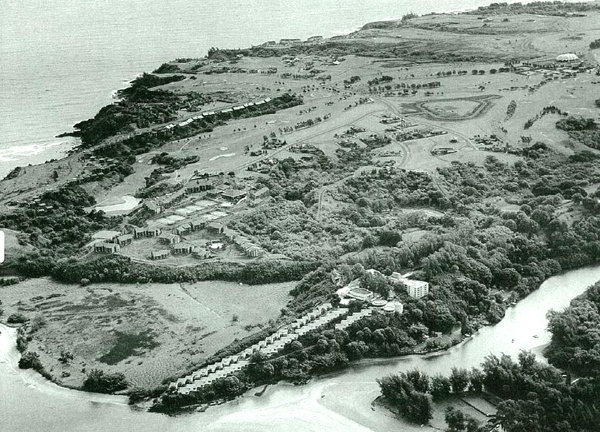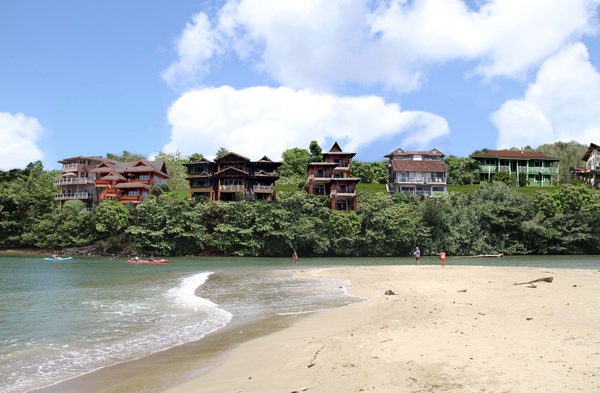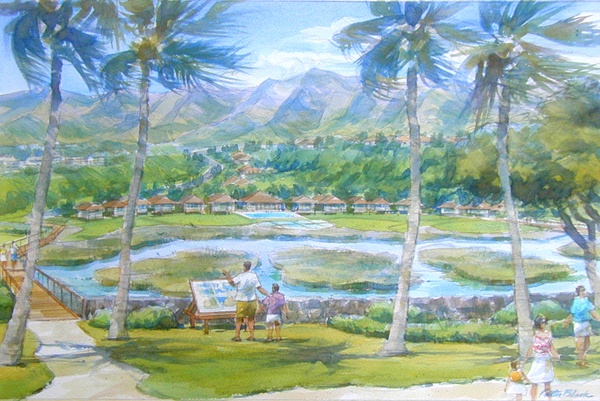Hanalei vs. Hanalei
HANALEI — One of the most significant developments proposed in Hanalei Bay since the building of the Princeville Hotel (now the St. Regis Resort), is meeting staunch opposition from a rapidly growing group of people, despite attempts from developers to assure that they are doing the right thing.
Hanalei Plantation Resort representatives are saying this is the most environmentally and culturally responsible visitor-oriented project ever to be proposed in the state, and will set the standards for future development.
“I think there are a lot of clarity that needs to be made with regards to who we are as a company and the proposed development,” said Michelle Swartman, director of land and community development at ‘Ohana Hanalei LLC, the company in charge of the development.
“It’s important for people to understand what are the guiding principles of our company,” she said. “One, it has to make economic sense. Two, it has to be respectful of the culture and very sensitive to the environment.”
On the flipside, the Hanalei Bay Coalition has painted a somber picture of what could potentially become to one of Hawai‘i’s most beautiful viewplanes. According to the coalition, the ridge is at high risk of being covered with a string of high-end mansions perching over Hanalei River, similar to what has happened on the bluff overlooking Kalapaki Bay in Nawiliwili.
“People are shocked that an element like that could be encroaching in Hanalei,” coalition member Hayley Ham Young-Giorgio said. “Not to mention whatever the environmental aspects are.”
The coalition’s lobbying against the project has been so aggressive and successful that they have already gathered more than 3,400 signatures in a petition opposing the development. They ultimately want the man behind the project, billionaire and eBay founder Pierre Omidyar, to donate part of the project, the ridge overlooking Hanalei River, to conservation.
And it is conservation — and restoration — of a monumental-size historical and cultural feature that is in the developers’ plans. They say they will bring back to life a giant Hawaiian fishpond currently covered with dirt, mud and invasive species, and lined up with a 1,000-foot-long rock wall that is 600 years old.
“It is something we owe it to our kupuna, we owe it to our community and we owe it to our children to preserve and to celebrate and to share,” Swartman said.
Project overview
The proposed Hanalei Plantation Resort land, bought in 2008 by Omidyar, extends from the bottom of the St. Regis Resort up to the north margins of Hanalei River, excluding a few riverbank parcels up the river. Omidyar bought the property in 2008. The land is mostly zoned for hotels and resorts, with some of it in conservation.
A ridge coming down from Princeville and extending to Hanalei River mouth is the crux of this battle. It is a proposed development there that the coalition is primarily concerned with. The project includes subdividing the ridge into 34 residential lots, roughly 15,000 to 20,000 square-feet each, with 25 of those lots facing the river and nine lots on the opposite side of the ridge. The current plans are to sell those lots individually, according to Swartman.
On the low lands between the ridge and St. Regis Resort lays the project’s second phase: An 86-room resort, bungalow style, separated from the ocean by a marsh full of all kinds of invasive species. In the past, the marsh had been used for taro farming and cattle ranching, Swartman said.
Between the marsh and the sandy beach, a roughly 1,000-foot-long rock wall estimated to be there since A.D. 1400 has gotten archaeologists to believe the marsh was once a working fishpond, which later got filled with mud and dirt.
But when core samples were taken from different parts of the marsh, coral was found. Now, archaeologists are thinking that area may have been a small bay, later turned into a fishpond by the early Hawaiians. If that is correct, the adjacent ridge would have been a point extending into the ocean, with the river on one side and a cove on the other.
“Based on (archaeologist Hallet Hammatt’s) findings, we believe the ocean extended to this bay, and this plateau was a point to the ocean,” said Swartman, pointing to the ridge.
She said many had no idea the fishpond existed — in the heart of Hanalei Bay. The project includes restoring the area to a working fishpond, bringing it as much as possible to its original condition six centuries ago.
The fishpond would not be used for commercial purposes, but it could be available for educational opportunities. The fishpond would also filter sediments coming from Princeville’s surface water that flows into Waileia Stream, which currently flows into Hanalei Bay, according to Swartman.
There is one beach access on the property, and the developers plan to add another access north of the property.
The ridge
The coalition has no problems with the fishpond and the 86-bungalow project on the other side of the ridge, as long as ‘Ohana Hanalei meets environmental and cultural criteria, coalition member Carl Imparato said. Even if the developers decide to increase their density there to 120 units, as long they meet environmental and cultural criteria, “we can live with that,” he said.
“This out here is the real problem,” said Imparato, pointing to the ridge by Hanalei Bay River.
“It’s right there in your face,” Ham Young-Giorgio said of the development on the ridge.
If the county or the state has implemented a rule to protect the viewplanes, the ridge is “obviously part of it,” she said.
“We need to come to some sort of agreement where we can clearly agree that this is part of the viewplane,” Ham Young-Giorgio said. “(The project) doesn’t deserve to be in this area. Taking that out and compromising with the rest of the project is obviously what we’ve been talking about.”
Imparato said Ham Young-Giorgio is correct; there are various ordinances protecting the viewplanes, and in the North Shore development plan there is consideration for viewplanes.
“But unfortunately it’s not saying that the viewplane must be protected at all costs,” he said. “It becomes a qualitative thing for the planning commissioners to make judgments on, trying to weigh against on what they perceive to be the developer’s political power.”
Coalition member Maka‘ala Ka‘aumoana said the entire ridge should be put into conservation status, with a “good, hefty tax credit” to Omidyar.
“I think he has the right capacity to do it, I think he has the right mind, I think he has the right heart, given the kinds of things that he’s done statewide,” she said of Omidyar.
Imparato said keeping the ridge in conservation is the only way the issue can be addressed, as far as he can see.
“There should be nothing that destroys this viewplane, it’s the most important viewplane on the island of Kaua‘i,” he said.
During the recent celebration of the 100 years of Hanalei Bridge, people were talking about how essential the bridge is to the Hanalei’s character, according to Imparato, who said another essential feature to Hanalei is the bay and the view of that ridge.
“When we talk about putting something on that ridge, we talk about transforming the very nature of Hanalei,” he said. “Jesus, if you build there, what did we save with 35 years worth of fighting for that bridge? What did we save if we let Hanalei go that route? What is Pierre Omidyar thinking?”
There are some residents, however, who may experience direct impacts from the project, but are not against it overall.
For about a year, Thames Goodwin has been participating in steering committee meetings organized every other month by the developers. He has been living for more than 10 years on a Princeville property adjacent to the proposed project.
“They have the ability to put a hotel up on that ridge, but they are not going to do that,” said Goodwin, adding that the developers could put 400 units in the entire property, but will rather leave a smaller footprint on the ridge.
“The ‘Ohana group has expressed a great interest in making sure they don’t destroy the beauty of Hanalei Bay,” he said.
Homes
Swartman said what happened in Kalapaki can be avoided by following restrictions in the county Comprehensive Zoning Ordinance and in the North Shore development plan.
Mala Fu and her husband own a home on Plantation Road, about a quarter-of-a-mile before the project’s entrance in Princeville.
“From my understanding, these are single stories, these aren’t two, three, four story buildings,” Fu said. “I know the developers are very concerned about the birds, the lighting, the scenery, the way the buildings are going to be.”
Goodwin said the steering committee has focused on the impacts on the viewplane and how well those homes are going to be designed to blend in with the environment.
Current restrictions limit building heights on the North Shore to up to 25 feet. Imparato, however, said this restriction could be circumvented due to the topography of the lots, a mix of a narrow plateau and steep terrain downhill.
A 12-foot setback would not leave much flat land to build a 7,000-square-foot home, the average size of homes built on multi-million-dollar lots, he said.
“What that means is, you’re going to at least put two stories in,” said Imparato, explaining that multi stories would be allowed as long as it goes downhill, because the height restriction is measured from the property’s entryway.
Swartman said staggered multi-story buildings is not what ‘Ohana Hanalei envisions for the property, but to prevent this from happening it’s something they still have to explore. They are still in the process of trying to understand what can be built, and have recently hired a geotech to try to understand the soil.
Fu said she walks at Hanalei Beach every day, and lately she has been paying close attention to the bluff overlooking the river. She said the buildings will stand out, and it’s not going to be a “nice sight,” but the developers’ plans are a lot better than what it could be.
And there is also the issue of the natural vegetation providing a buffered view from Blackpot Beach Park. The developers are saying the vegetation will be left in place, but the coalition is saying there are no guarantees for that.
“In the end, we have to assume that not one tree will be left standing, because any tree that (the homeowners) leave standing will block their view, their $4 million view,” Imparato said.
Swartman said it’s just as important to the homeowners to have their privacy. When asked what would happen if the homeowners’ association got together and decided to cut the trees, she said, “Depends on how you write your documents, right?”
Precedence
Swartman said that about 50 or 60 years ago there was a 210-room hotel on top of the ridge. Then Club Med came in, and the density was still at 210 units.
After Club Med shut down, developer Bruce Stark got approval for 204 hotel units. He started construction but never finished it. Today, an empty swimming pool, concrete slabs and basic infrastructure tell the story of a halted development.
“There is precedence there, there was a hotel there,” Swartman said. “It was a thriving hotel that was enjoyed by all, and it was a piece of paradise and it was under the guidance of Grace and Gus Guslander.”
Goodwin said it has taken a long time for someone to replace the former development on the ridge.
“The viewplane, it is what it is today, but it used to be something very different, and what it used to be was very ugly,” Goodwin said.
The Hanalei Plantation Resort may have a reduced density of 86 hotel rooms and 34 homes, but Imparato said this is relative. The hotel rooms will measure 400 to 500 square feet, but the homes on the ridge will be much larger.
“When Stark got approved, that was 125,000 square feet,” Imparato said. “The 34 mansions alone heads up to about 250,000. That’s already twice as much as anything that has been up there, or even approved.”
Ham Young-Giorgio acknowledged there was a previous development on the ridge, and that people have a right to use their property.
“But when you put it into perspective … look at what Hanalei was before, there was nothing around,” she said. “Hanalei was still a natural environment.”
Today, the concentration of development just keeps getting “thicker and thicker and thicker,” she said.
“There’s got to be balance in Hanalei, that’s what we are trying to do,” Ham Young-Giorgio said. “For me, growing up in Hanalei, this town is really madness right now.”
Swartman also used the word “balance.” She said there has to be a balance between preserving historical sites, creating a viable business and having an economy that is beneficial to the island, and there has to be “sensitive and sensible growth,” where the people can participate with concerns and feedback.
Clarity
“It’s about the community finally finding out what’s going on with that, and people are getting upset,” said Ham Young-Giorgio, adding that community in Hanalei didn’t even know what was happening there. “People deserve to know.”
Swartman, however, said ‘Ohana Hanalei has had five steering-committee meetings so far, and they have had “insightful discussion” with many key community members. Some who attended included the presidents of the Hanalei to Ha‘ena and the ‘Anini community associations, members and the executive director of the Princeville Community Association, a representative from Hanalei Watershed Hui and others.
“It has always been our intent to go out to our larger community, but we wanted to first get some insights and comments and hear what those main concerns may be,” said Swartman, adding that they are in the early stages of community outreach.
Goodwin said the developers have brought experts from all over the state, and have consulted a great deal with them as to what needs to happen to make the project a reality. These same experts have come to the steering committee meetings to share their findings and their plans.
He said ‘Ohana Hanalei invited to the meetings those they knew would bring participation rather than straight opposition, but there was still an opportunity for anyone to participate in any of the meetings simply by requesting.
Fu said she really appreciates that the developers are reaching out to the community.
“They want to make it pono,” said Fu, adding that they have asked as many kupuna as they could to provide their mana‘o, sometimes through one-on-one conversations.
“You don’t get that from a developer,” she said.
Fu’s own father was one of those kupuna.
“He pretty much knew every nook and crevasse here in Hanalei,” Fu said of her father, who recently passed away.
Coalition members, however, have questioned ‘Ohana Hanalei’s ways of seeking kupuna input.
Ka‘aumoana accused ‘Ohana Hanalei of cherry picking the kupuna to support the project.
“Getting a kupuna to sign an affidavit for a development project, where do you get that?” she said.
Ham Young-Giorgio said that to select a few people in the community for their steering committees is a “huge disrespect” to the community.
Imparato said the developers are trying to gain momentum by “buying off” select people in the community.
‘Does Hanalei
need it?’
Swartman said there is a need to provide jobs and opportunities for locals, so they are able to afford to continue living here.
“I don’t think the jobs argument carries that much weight,” said Imparato, adding that there’s a lot of money to be made and many jobs to be created by also putting a maximum-security prison or a nuclear power plant on the point. “Jobs isn’t everything.”
Swartman was born on O‘ahu, and currently lives here with her Kaua‘i born-and-raised husband and their three children. She said she loves this island and wants to be able to raise her children here, to play at the beaches in Hanalei or anywhere on the North Shore.
Fu’s grandfather came to Kaua‘i from Honolulu as young child and settled in Hanalei. It was there that Fu’s father grew up. He worked at Lihu‘e Plantation, which later became the Princeville Ranch. The proposed project’s lands were Fu’s playgrounds as a child.
“Hopefully we can all come together and see a little bit of good in it,” Fu said.
Ham Young-Giorgio was also born and raised on Kaua‘i, and comes from a traditional family that has been here for generations. She posed the million-dollar question regarding the proposed development: “Does Hanalei need it?”
For more information on the project, visit www.
hanaleiplantation.com.
Visit www.facebook.com and search “save Hanalei Ridge” more information on the opposition.




